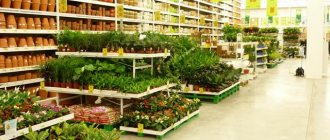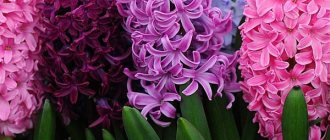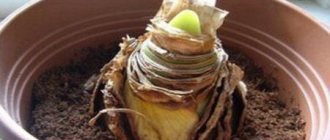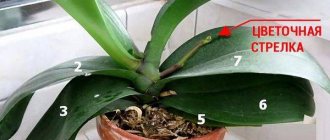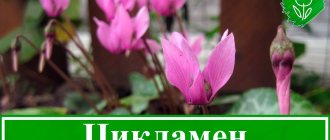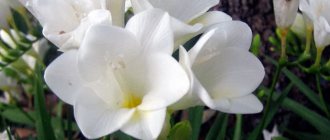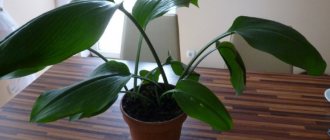Growing hyacinth is not a problem. It is much more difficult to achieve flowering by the desired date. We'll tell you how to make hyacinths bloom for the New Year, Valentine's Day or March 8th.
Hyacinth bulbs are used not only for planting in open ground, but also for forcing at home for the New Year, Valentine's Day and March 8th. Of course, you can not complicate your life and just buy your favorite flower in a pot on the eve of the holiday. But in fact, the process itself is quite simple. In addition, self-grown flowers will be cheaper. And the joy of seeing tender buds bloom cannot be compared with anything!
Hyacinths are easy to force. Even if you make a mistake, you are unlikely to ruin the bulbs. The worst thing that will happen is that flowering will occur earlier or later than planned, and the sultan-inflorescence itself will not stretch enough.
Forcing hyacinths in water
agardenforthehouse.com
Hyacinths can be grown not only in soil, but also in water. This method allows you to get a beautiful flower even faster. However, certain rules still need to be followed.
Firstly, it concerns capacity. It is desirable that this be a special vessel. But if you don’t have one, you can use a regular tall glass.
Secondly, you should not use tap water. It is better to replace it with melted one. Pour the liquid so that, after placing it on the edges of the glass, there is 1.5-2 cm between the bottom of the onion and the water.
Also place the bulbs for forcing hyacinths in water in a cool, dark place, for example, in the refrigerator, where they will spend several months until roots appear. Then move the hyacinth to a warmer place and cover with a cap. The cap can be removed only after the sprout appears.
How to choose a good healthy plant in the store
There are two options for “purchasing” hyacinth:
- Purchase seed material (bulbs) and grow plants from them yourself.
- Buy grown (blooming, usually) hyacinth.
In the first case, you need to choose strong, medium-sized bulbs (4-6 cm in diameter), without damage, darkening or dents. This option is preferable when it comes to creating a flower bed with primroses.
However, if you properly care for the purchased plant, then there is a chance to save the bulb and then plant it in open ground.
Resuscitation of hyacinth bulbs after forcing
gardeningknowhow.com
Forcing greatly depletes the bulb. Therefore, after the hyacinths bloom, many people prefer to simply throw away the used planting material. But if you put in a little effort, the bulbs can be revived. To do this, follow our recommendations.
- Remove dried inflorescences.
- Fertilize the hyacinth once with fertilizer for bulbous plants.
- Raise the air temperature to 22-23°C and continue to light the flower and water it moderately for a week. This is necessary to activate the process of regeneration bud formation.
- After a week, reduce watering and leave only natural light.
- Stop watering completely when the leaves begin to yellow.
- Place the pots on their side to ensure better flow of nutrients from the green mass to the bulb.
- Remove the bulb from the soil after the leaves have completely died. Dry it and store it at 17°C until planting.
The largest bulbs can be used for re-forcing. But be prepared for the fact that the flowering will no longer be so lush. It is better to plant the hyacinth in the ground so that it can fully regain its strength.
Forcing hyacinths is one of those activities that, once you try it, you can’t stop. After all, their delicate or, on the contrary, bright inflorescences are a real spring miracle, which is so missed during the long winter months.
Diseases and pests
Growing hyacinths involves protection from diseases and pests that can destroy plants.
Yellow bacterial rot
Infection is indicated by the condition of the plant: it begins to lag in growth and becomes weak. There is either no flowering, or the arrow is short, and the buds quickly fall off. Brown, wet spots appear on the leaves.
All these signs are the result of damage to the bulb that feeds the above-ground part of the plant. It rots, the tissues become soft, transparent, and a strong unpleasant odor appears.
In order to detect infected bulbs, they are kept at high temperatures and fairly high humidity before planting. These two factors provoke the development of rot if the planting material is infected.
Infected plants are destroyed and the hole is treated with a bleach solution to prevent re-infection.
Parasitic blossom end rot
A fungal disease that manifests itself as brown dents on flowers and leaves. The roots gradually rot, water exchange is disrupted and the plant dies. Rot becomes a “start” for the development of other pathogenic microorganisms.
To prevent the occurrence of the disease, the soil before planting is treated with fungicides and the temperature regime is observed.
Mosaic
Whitish spots that appear on the leaves indicate infection with mosaic disease. In these places, the green pigment chlorophyll is destroyed, the plant does not receive enough nutrients, growth and development are disrupted, which can lead to death.
The causative agent of the disease is a virus that lives in leaf cells. It is carried by insects - parasites. Gradually, the leaves die off, and subsequently the stem and root system undergo necrosis. Affected plants are destroyed.
Gray rot
Gray rot appears quite early, as soon as the first green arrows sprout. They become pale gray, with yellow (brown) spots; the tissues become necrotic, and the bulb and the plant as a whole die.
Pests
Prevention helps against damage by thrips and nematodes, the main enemies of hyacinths: before planting, a layer of the drug Fitoverm is laid in the soil, which protects against parasites.
Possible problems when growing hyacinths (table)
| What problem arises | The reasons for its occurrence | What to do |
| 1. Hyacinths do not bloom, but they expel abundant green mass | The onion is too small; heavy soil without drainage; strong deepening of the bulb | Wait until the bulb grows to the required size (5-6 cm in diameter). Change the soil and plant correctly |
| 2. Poor growth, delayed flowering | Transferred to heat too early; lack of minerals in the soil | Feed the plant |
| 3. Non-simultaneous flowering in the garden | Different flowering times for different varieties; bulbs of different sizes | Plant identical bulbs of the same variety at the same time |
| 4. Yellowing and falling leaves | Weak watering; low lighting or direct sunlight; pest infestation | Normalize care, make sure there are no diseases and parasites |
| 5. Rotting of the bulb, cessation of flowering without signs of disease | Improper watering, water getting into the root collar | Water at the edge of the pot |
Popular varieties for indoor growing
Based on Eastern hyacinth, numerous hybrids , the descriptions of which differ:
- structure of the corollas: simple and terry ;
- petal color: white, yellow, orange, blue and purple, pink, red and black;
- Flowering dates: early, mid and late blooming.
Oriental hyacinth hybrids are unusually decorative; the Internet is replete with numerous photos of them. Most are suitable for growing indoors . The most common varieties found at home are:
- Ostara, with high (up to 30 cm) peduncles and loose purple inflorescences about 13 cm long, maintaining freshness for 3 weeks.
- Rosalia, different pink shades of inflorescences, consisting of 15-17 small (diameter 2 cm) buds with a short flowering period.
- Sunflower, with peduncles up to 20 cm high and medium-density cream inflorescences formed by small (3.5 cm) double flowers. Blooms for 2 weeks.
- Amethystcharacterized by a light purple color dense inflorescences up to 10 cm long and a one-week flowering period.
- La Victoire, which have gained popularity thanks to their dense inflorescences of spectacular bright red tones.
Preparing the pot
The growing container must be at least 1.5 times the size of the planting material. Holes are needed in the bottom of the container to allow oxygen to circulate in the soil. When choosing a container, it is worth considering the number of bulbs. So, if this is a single planting, a pot 15 cm high and with a diameter slightly larger than the planting material will do.
If you want to grow several specimens in one container, you must take into account that the bulbs should not come into contact with the walls of the container, and maintain a distance of at least 2 cm between them. Before using the pot for its intended purpose, it must be disinfected - doused with boiling water (if the material allows) or rinsed with a pink solution of potassium permanganate . Then a drainage layer about 5 cm thick of coarse sand, pebbles, small crushed stone, etc. is laid on the bottom of the dry container.
Did you know? According to legend, hyacinth got its name from the Greek god Apollo. At the site of the death of his favorite Hyakinthos, this beautiful flower grew.
How to properly prepare the soil for planting
For forcing hyacinths, light, loose soil is required. You can purchase it at specialized outlets or prepare it yourself. To do this, combine soil from the garden, peat and coarse sand in equal parts, and mix everything thoroughly. For acidic soil, add dolomite flour according to the instructions on the package.
The substrate is poured into the pot, leaving a third of the height empty (not forgetting the drainage layer), lightly compacted and watered. No additional additives are added to the planting soil mixture, since all the necessary nutrients are already contained directly in the bulb.
You brought a purchased flower home, how should you care for it?
Typically, flowering hyacinths are not replanted, but this rule does not apply to plants purchased in garden stores.
Hyacinth bulbs can be purchased at any time of the year. If there is no intention to immediately send it for forcing, then place it in a cool place for storage at a temperature of 6–9°C. This will stop the growth processes and begin a period of rest. If a bulb is purchased in a pot, it is placed in a well-lit place for forcing.
Is it worth replanting from a store pot?
As to whether it is necessary to replant hyacinth from a store pot, gardeners have differing opinions. Some believe that it is undesirable to injure a flower by transplanting. Others do not see any danger to the plant in this process. In order to decide what to do next, we evaluate the situation according to several parameters:
- flower condition: rooted bulb, there are sprouts, blooming;
- pot size;
- what will be done with the plant after it blooms.
Most often, hyacinths are sold in their best commercial form: blooming. Moreover, the bulbs are planted in such small containers that the soil is almost invisible. The vegetation of plants in such conditions is maintained by watering with chemicals. Once this process stops, the flower may die. Therefore, in order to save the life of the flower, after purchase, the hyacinth must be transplanted into a pot with soil, regardless of whether it blooms or not. If it was purchased in a container with a sufficient amount of substrate, it is better to refrain from replanting. After the hyacinth has bloomed, the bulb is dug up and sent for a period of rest.
Recent Entries
Lilac perennials that are beautiful, compact and do not crowd out other plants Why when buying seedlings you should not take the sellers’ word for it and how to determine the age of the plant using 3 signs Tomato seedlings have turned purple or whitish: why the color has changed and how to save the plants
Conditions for growing hyacinth in a pot
Try not to place hyacinths on windowsills, where there is a high probability of drying out from radiators
A pot of hyacinth is placed in any bright, warm place. Proximity to heating devices: radiators and various heaters is undesirable. For normal growing season, the plant needs room temperature.
During the period of ripening of the buds, hyacinth can be illuminated in the evenings with an incandescent or fluorescent lamp. The optimal temperature for flowering is 20°C. Watering should be moderate but constant. The soil should not be allowed to dry out. It is important to prevent water from getting on the top of the bulb and in the axils of the leaves.
Therefore, water is added at the edge of the pot. This will inevitably cause gradual erosion of the substrate. In order to avoid this, the container with the flower is periodically turned. This is also useful for making the plant trunk grow vertical. If necessary (if the soil is not nutritious enough), fertilizing with mineral fertilizers is possible.
The conditions listed above are considered ideal for growing hyacinth in a pot. But it is not always possible to provide them. However, there is no need to worry about this: hyacinth is quite unpretentious and will definitely bloom at room temperature and normal indoor lighting.
Reproduction methods
Hyacinth - home care, growing in a pot
Propagation of hyacinths can occur in several ways:
- Baby bulbs;
- Seeds;
- By notching or cutting out the bottom;
- Bulbous scales;
- Leaf cuttings.
Of the above, the most difficult question is how to grow hyacinth from seeds. The fact is that this method is used by specialists in the field of breeding work. This is the most complex and time-consuming method, therefore it is rarely used in ordinary floriculture.
During the period of active growth and development, the mother's bulb is overgrown with children. After flowering, they are usually easily detached, then they can be planted separately. If they hold tightly, then it is better to grow the mother bulb together with the children. Next year it will be much easier to separate them.
Hyacinth can be grown artificially - by cutting the bottom. As a result of such manipulations, the bulb produces from 8 to 15 children and is no longer restored. For the procedure, you will need material that has gone through the resting stage and has accumulated a large amount of nutrients. The bulb should be large enough and not damaged. The material is washed, dried, the scales are separated from it, and then treated with a disinfectant. Next, using a sterile instrument, make 4 or 2 (depending on the size of the bulb) cross-shaped cuts up to 0.6 cm deep. Then the bulbs are sprinkled with charcoal and dried again at a temperature of 20-22 degrees for 24 hours. The opened cuts are sprinkled with crushed coal and planted in the soil, in a dark place with the same temperature. New bulbs appear after about 3 months, then they are separated and grown over the course of 2-3 years.
Reproduction by cutting the bottom
To propagate hyacinth on an industrial scale, the method of cutting the bottom is used. It will allow you to get up to 40 children per unit of planting material. This procedure is carried out at the end of the resting phase. Here it is very important to cut the bottom as carefully as possible so as not to damage the onion. To do this, it is better to use a teaspoon with a sharp edge. After the operation, they check that only the base of the scales has been removed, and that the center of the bulb is not damaged. Next, the cut sites are treated with a fungicide, after which the material is laid out in boxes with the cut side up. It is also possible to keep the bulbs on a wire mesh. For speedy tissue healing, the material should be kept at a temperature of 20-22 degrees. After a couple of months, new bulbs will appear on the scales. The parent bulb is placed in a pot so that the “young growth” is shallow under the ground. Future hyacinths are kept in a cold greenhouse; with the onset of spring warmth, they will begin to grow and young leaves will appear. The bulbs are dug up after the growing season is completed and planted for growing. Flowering is observed after several years.
Reproduction by cutting the bottom
Another example of how hyacinths reproduce is with the help of bulbous scales. To do this, take an onion approximately 5 cm in diameter and divide it into 4-6 parts. Next, the scales are separated from the bottom and placed in a plastic bag with river sand or charcoal (perlite can be used instead). The package is stored tied: six months - at a temperature of 20-25 degrees, six months - at a temperature of 17-20 degrees. Lighting should be diffused. As a result, 1-3 bulbs are formed at the base of the scales.
Propagation by leaf cuttings should be made when buds appear. From each specimen, take 2 leaves, cut at the base. After treatment with a growth stimulator, they are placed in a container with sand, deepened by 3 cm. The box is covered with polyethylene and kept so under the following conditions:
- Diffused lighting;
- Air temperature – from 10 to 15 degrees;
- Humidity – 90%.
The bulbs will form in a month or a little more, and after another couple of months the first roots and leaf blades will appear. From this moment, the “young growth” can be moved to the garden bed. One cutting produces from 8 to 10 children.
